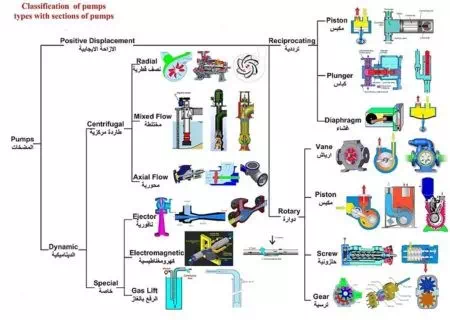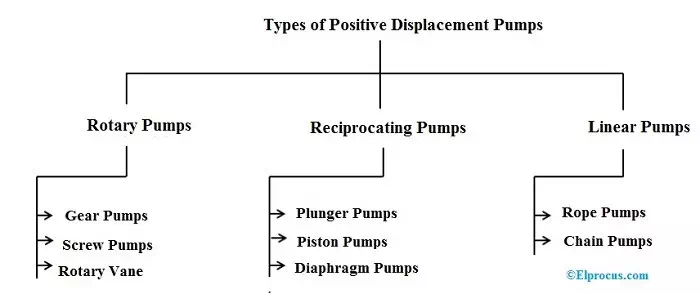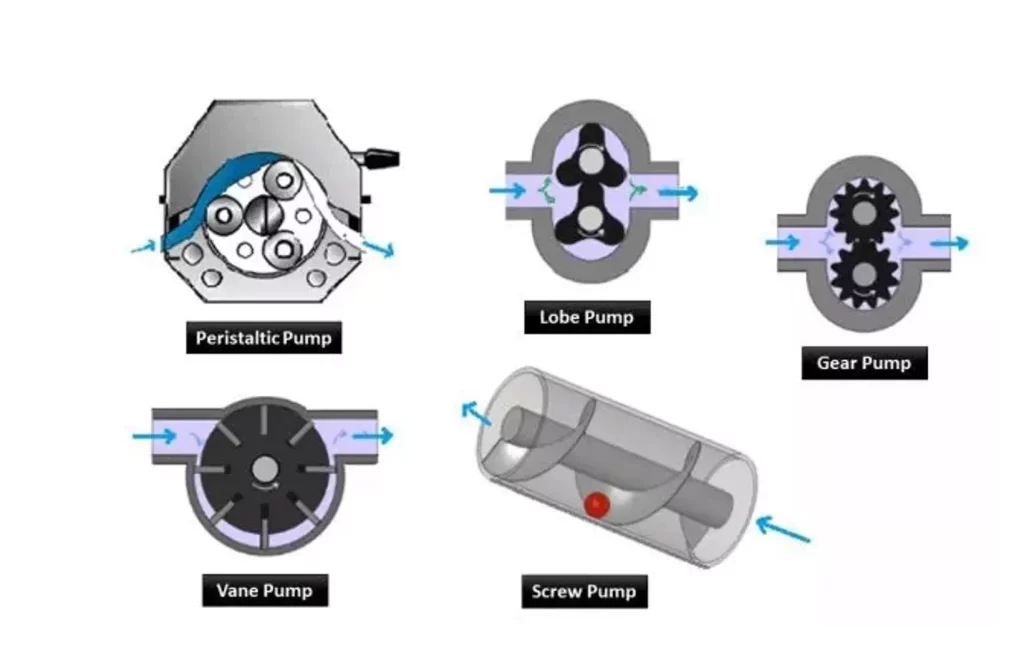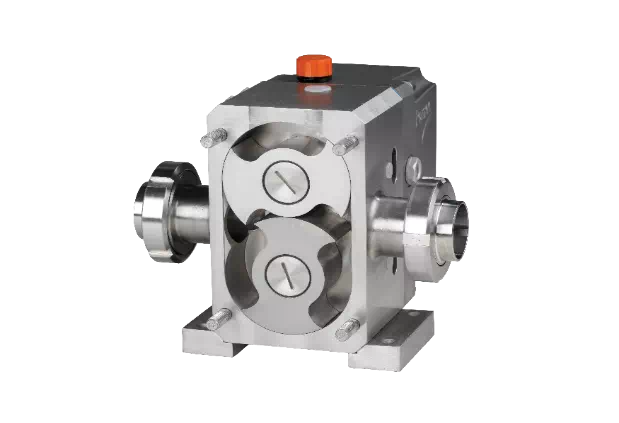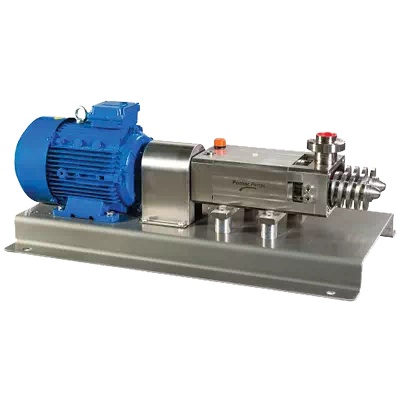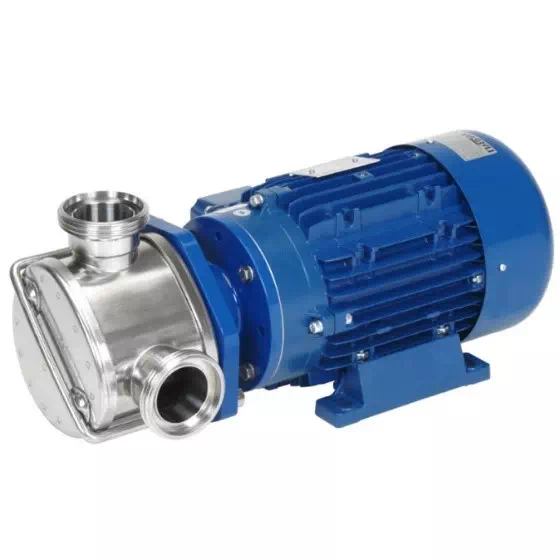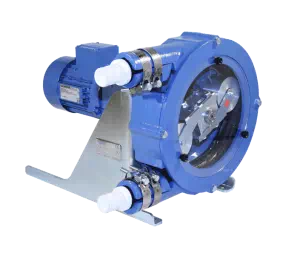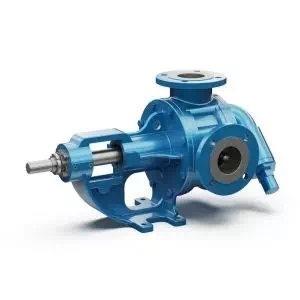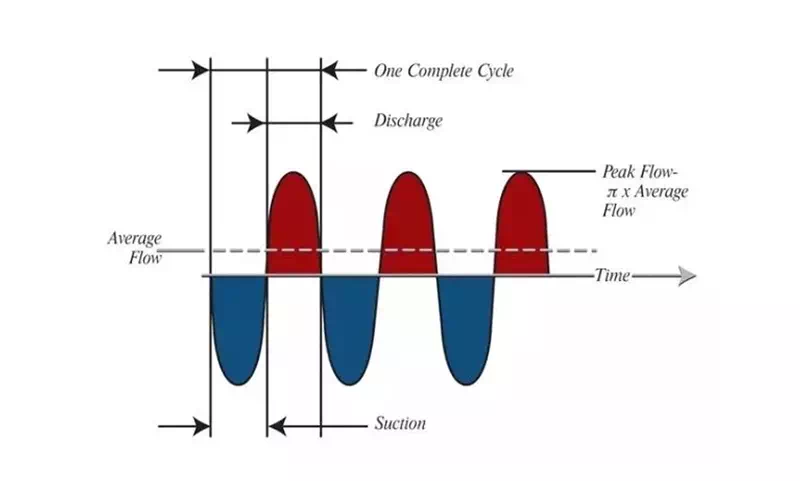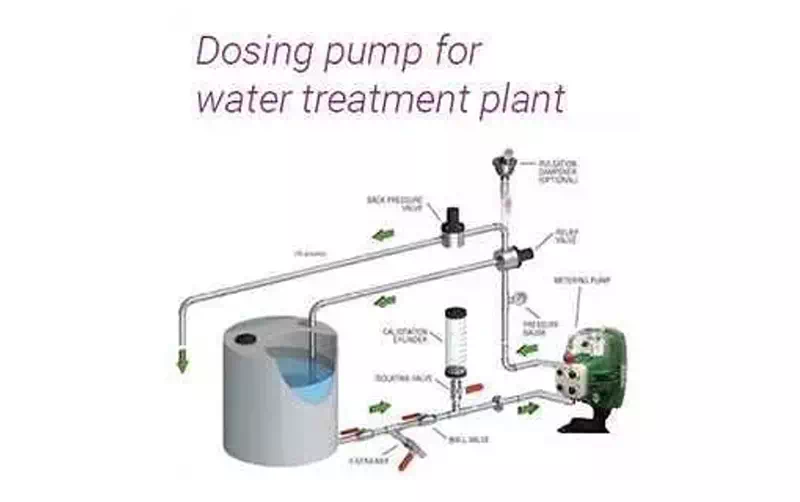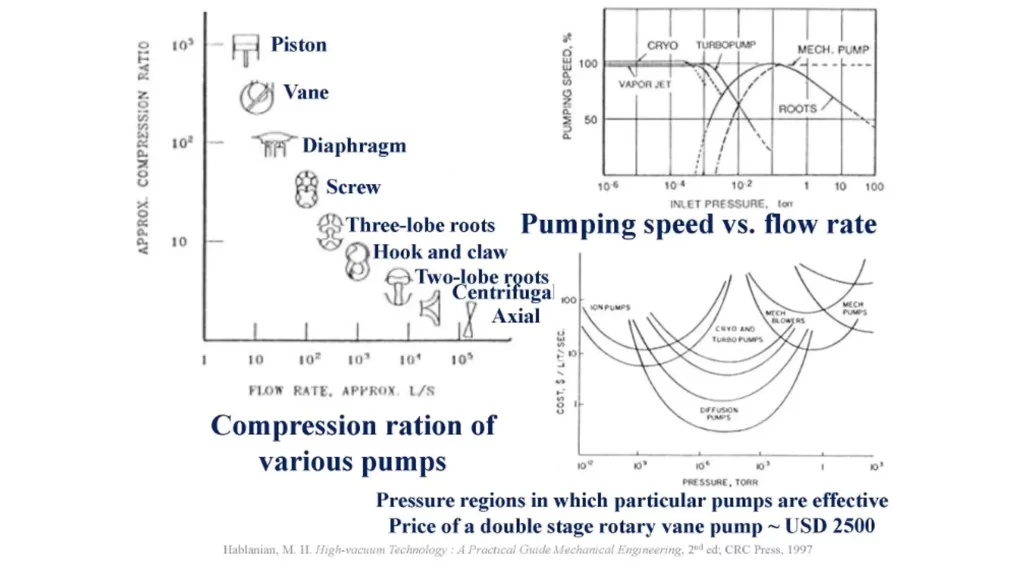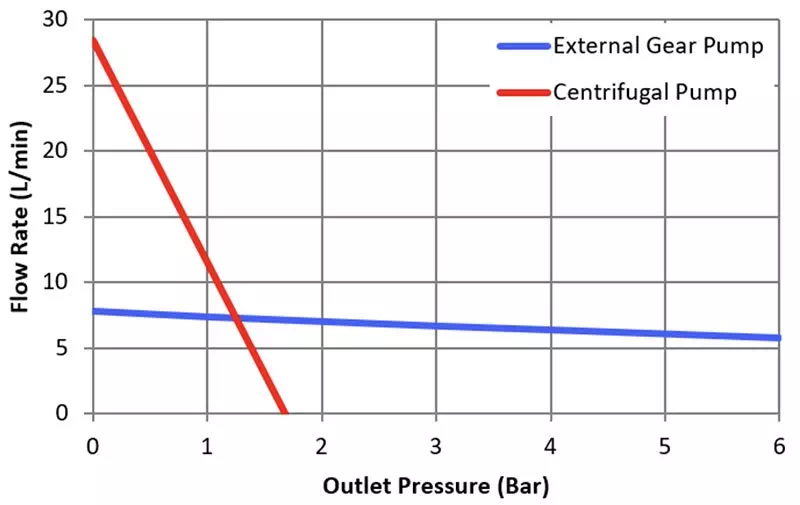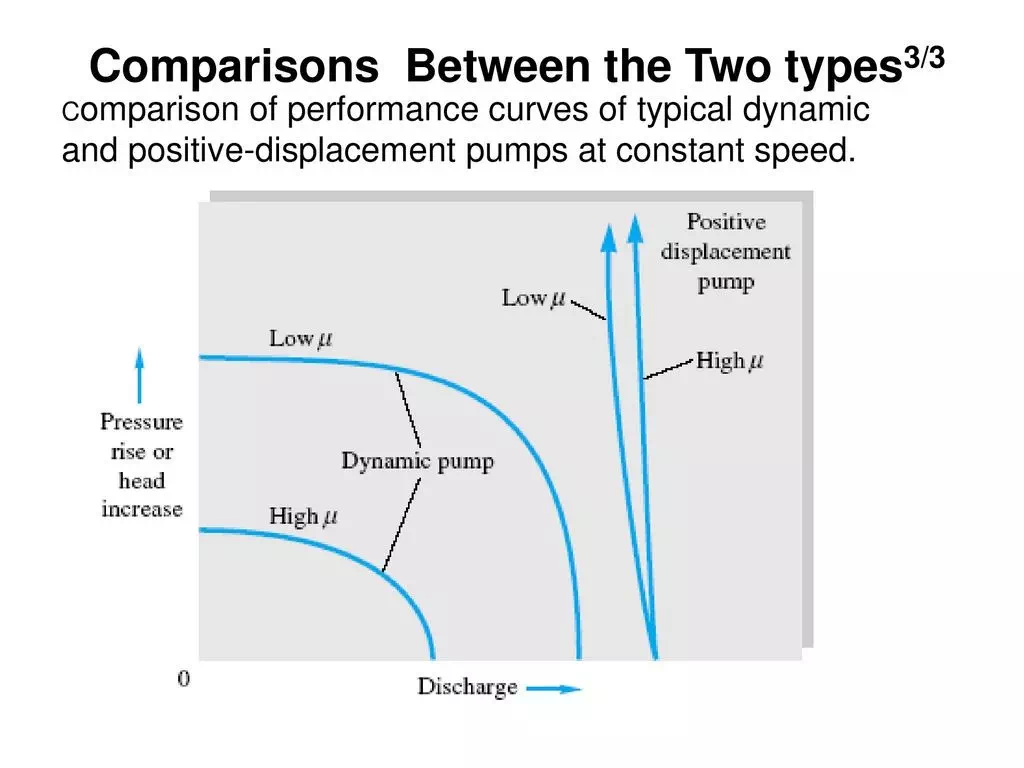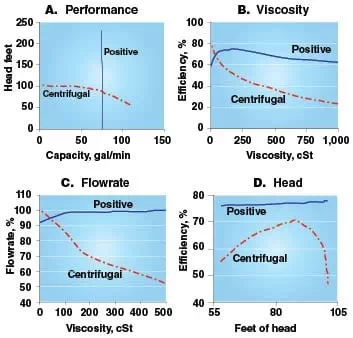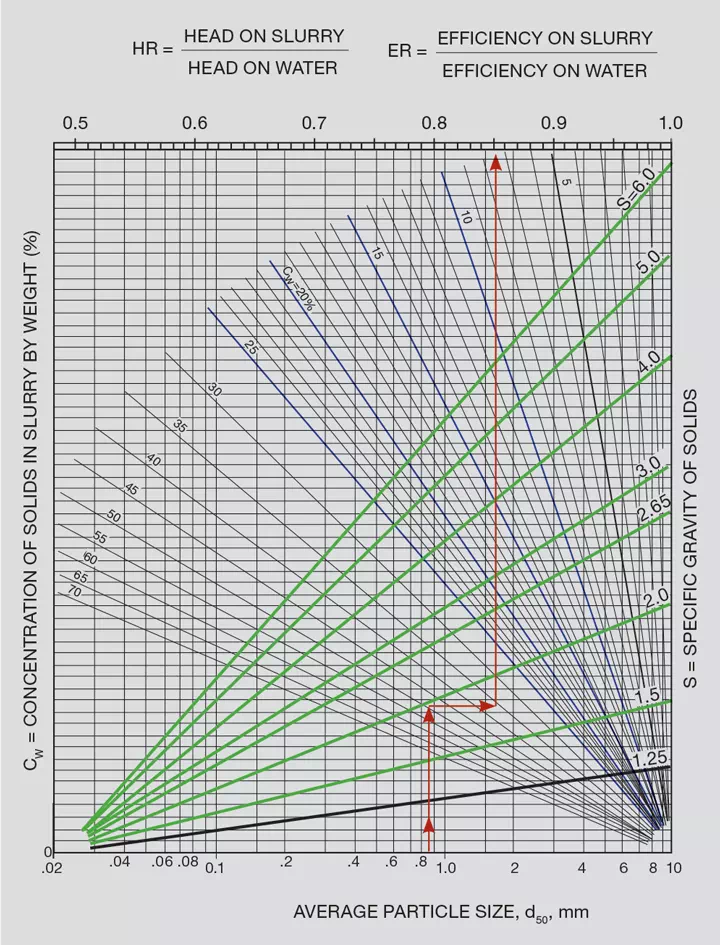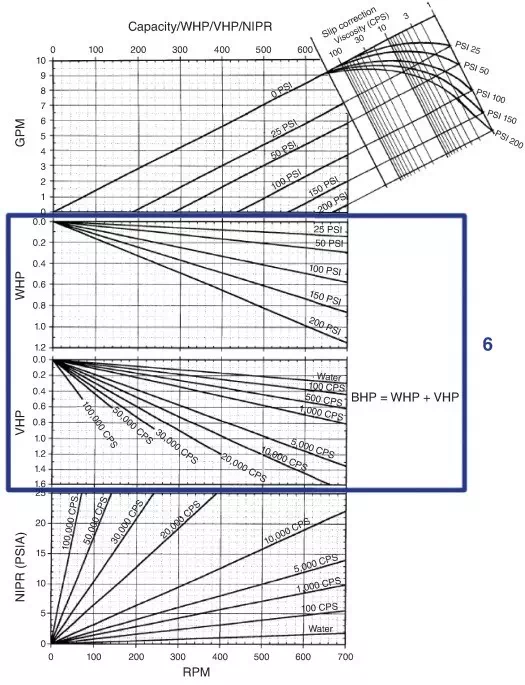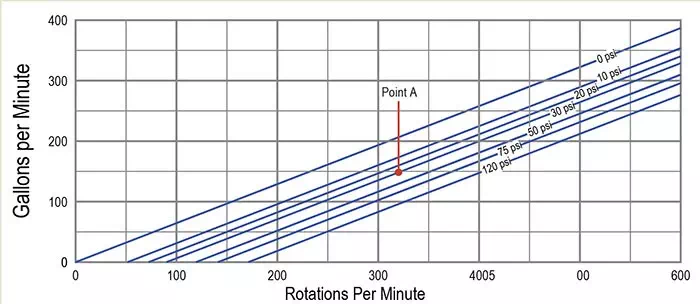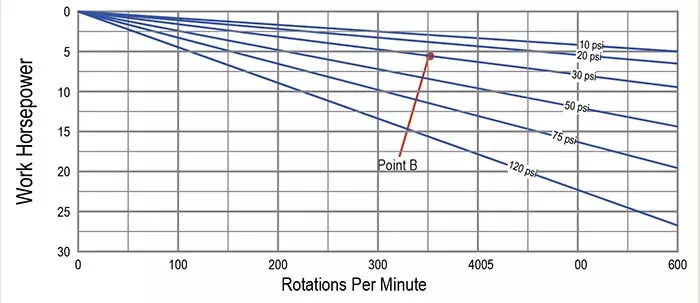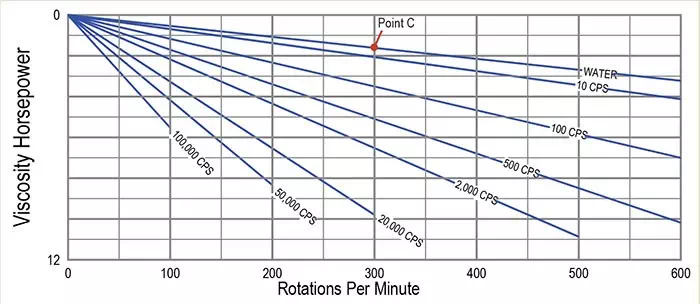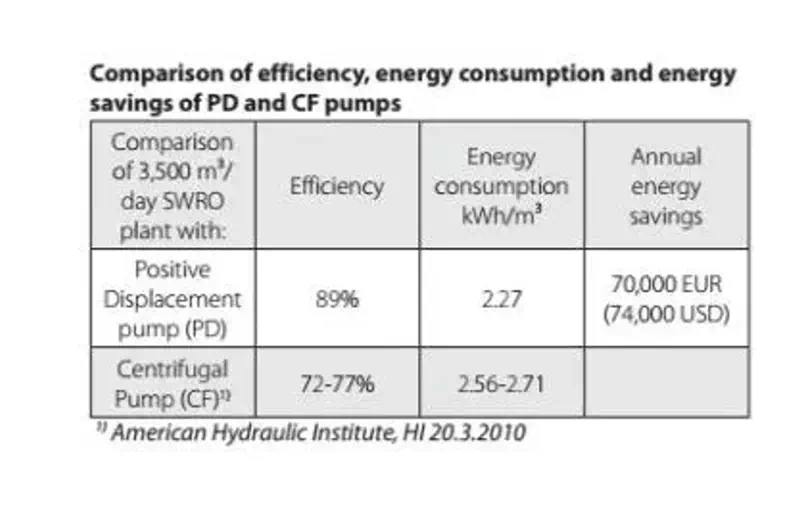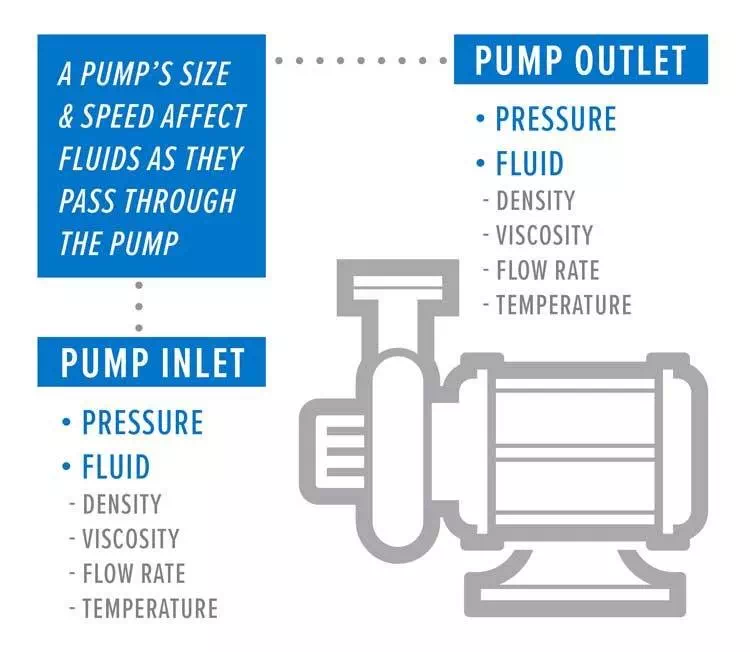สมรรถนะของพีดีปั๊ม
PD ปั๊มเป็นปั๊มที่ให้ปริมาณการไหลคงที่ในแต่ละรอบที่หมุน ทุกชนิดของ PD ปั๊ม เช่น Reciprocating, Plunger, Diaphragm, Gear, Screw, Vane, Lobe, Peristaltic pump เป็นต้น. PD ปั๊มทุกชนิดใช้เป็นปั๊มวัดปริมาตร (มีเตอร์ริ้งปั๊ม หรือ Metering pump) ได้. ขนาดของปั๊ม (Capacity) จึงขึ้นกับขนาดของท่อดูด (Suction pipe size) ความหนืดของๆไหล (Viscosity) และความเร็วรอบ (Speed, RPM) เป็นสำคัญ
ปั๊มแบ่งเป็น กลุ่ม คือ
กลุ่ม 1 พีดีป๊ม (Positive displacement pump)
กลุ่ม 2 ไม่ไช่พีดีป๊ม (Non - Positive displacement pump)
กลุ่ม 3 ปั่มอาศัยแรงเหวี่ยง (Centrifugal pump)
แต่ละกลุ่มยังแบ่งเป็นชนิดย่อยๆ ตามผังที่แสดง
ความแตกต่างของพีดีปั๊มและปั๊มแบบอาศัยแรงเหวี่ยง
Difference between Positive Displacement & Non-Positive Displacement Pump
The difference between positive displacement and non-positive displacement pump mainly include pressure, efficiency, viscosity, performance, etc.
| Parameters | Positive Displacement Pump | Non Positive Displacement Pump |
| Pressure | These pumps work for high force applications, and the force might be 800 bar. | These pumps are used for low force applications and the pressure might be 18 bar to 20 bar.
|
| Efficiency | When pressure increases then the efficiency will automatically increase. | The efficiency will decrease at a lower pressure or higher pressure. |
| Viscosity | When the viscosity increases then efficiency will increase because of the frictional losses in the pump | When the viscosity increases then efficiency will decrease because of the frictional losses in the pump |
| Performance | When the pressure changes then the flow will change | When the pressure changes then the flow will constant |
สรุปความสามารถของพีดีปั๊มและปั๊มแบบอาศัยแรงเหวี่ยง
The following table summarizes the capabilities of centrifugal and positive displacement pumps
| Property | Centrifugal | Positive Displacement |
| Effective viscosity range | Efficiency decreases with increasing viscosity (max. 200 Cp) | Efficiency increases with increasing viscosity |
| Pressure tolerance | Flow varies with changing pressure | Flow insensitive to changing pressure |
| Efficiency decreases at both higher and lower pressures | Efficiency increases with increasing pressure | |
| Priming | Required | Not required |
| Flow (at constant pressure) | Constant | Pulsing |
| Shearing (separation of emulsions, slurries, biologican fluids, food stuffs) | High speed motor damages shear-sensitive mediums | Low internal velocity. Ideal for pumping shear sensitive fluids |
การใช้งานหลักๆของพีดีปั๊มชนิดต่างๆ
Positive Displacement pumps are commonly used for pumping high viscosity fluids such as oil, paints, resins or foodstuffs. They are preferred in any application where accurate dosing or high pressure output is required. Unlike centrifugal pumps, the output of a positive displacement pump is not affected by pressure so they also tend to be preferred in any situation where the supply is irregular. Most are self priming.
| Type of PD Pump | Application | Features |
| Piston pump | Water – high pressure washing; other low viscosity liquids; oil production; paint spraying | Reciprocating action with piston(s) sealed with o-rings |
| Plunger pump | Reciprocating action with plunger(s) sealed with packing | |
| Diaphragm pump | Used for metering or dispensing; spraying/cleaning, water treatment; paints, oils; corrosive liquids | Sealless, self-priming, low flows and capable of high pressures |
| Gear pump | Pumping high viscosity fluids in petrochemical, chemical and food industries: oil, paints, foodstuffs | Meshed gears provide rotary pumping action |
| Lobe pump | Chemical and food industries; sanitary, pharmaceutical, and biotechnology applications | Low shear and wear. Easy to clean or sterilise |
| Screw pump | Oil production, fuel transfer and injection; irrigation | Fluid moves axially reducing turbulence; capable of high flow rates |
| Vane pump | Low viscosity fluids; automotive transmission systems; fuel loading and transmission; drinks dispensers | Resistant to entrained solids and withstands vane wear. Design allows variable output |
การเปรียบเทียบความสามารถทางเทคนิคของพีดีปั๊ม
Comparing Technical Ability of different Rotary Positive Displacement Pumps
E = Excellent, G = Good, A = Average, P = Poor
| Abrasives | Thin Liquids | Viscous | Solids | Dry Prime | Different Pressure |
| Internal Gear | G | G | E | P | A |
| External Gear | P | G | G | P | A |
| Lobe | G | A | E | E | A |
| Vane | P | E | A | P | G |
การใช้งานของพีดีปั๊ม
Applications of Positive Displacement Pumps
These pumps are commonly used to pump high viscosity fluids where precise dosing otherwise high force output can be necessary. Not like centrifugal pumps, the outputs of these pumps are not affected by force thus they also have chosen in any condition where the supply is unequal. The best positive displacement pump examples are piston, plunger, diaphragm, gear, lob, screw and vane.
- Piston and Plunger pumps are used to pump low viscosity fluids, paint spraying, oil production, and high force washing.
- Diaphragm pump can be used for metering, spraying, treatment of water, oils, and paints.
- Gear pumps are used for pumping the high viscosity fluids within the petrochemical, food industries, paints, oils, etc.
- Lobe pump is used in food and chemical industries pharmaceutical, biotechnology, sanitary, etc.
- Screw pump is used in fuel transferring, production of oil, irrigation, etc
- Vane pump is used in low viscosity liquids, fuel loading, & transmission, etc.
ข้อดีของพีดีปั๊ม
Benefits of using a Diaphragm Pump
Diaphragm Pumps are air operated, they have 2 diaphragms inside, 1 diaphragm creates a vacuum to draw fluid into the pump whilst the other forces fluid out of the discharge port.
- Can run dry without damage to the pump
- Self-priming up to 5m from dry suction
- Fewer components than Standard Diaphragm Pumps on the market
- Air operated, no electricity needed!
- Can be fitted with LEAP technology in the centre block to save air consumption and save on running costs
- ATEX rated available
Lobe Pumps are versatile pumps designed for sanitary applications. The pump is operated by two rotating lobes that create a suction to draw more fluid into the pump, creating a pressure that causes a predetermined amount to flow out of the pump’s discharge port.
Benefits of Lobe Pump
- Sanitary Pump, fully EHEDG compliant
- ATEX rated
- CIP/SIP friendly (Clean In Place/ Sterilisation In Place)
- Discharge pressure up to 15 Bar
- Handling temperatures up to 140ºC
The Twin Screw Pump has been designed to combine all the benefits of a Lobe, Peristaltic, Centrifugal and Circumferential Piston pumps. We supply Screw Pumps with double screws, which rotate to move fluid forward through the pump casing.
Benefits Twin Screw Pump
- Self-Priming up to 8m
- Fully EHEDG compliant for sanitary applications
- Can dry run for brief periods
- Pulsation free pumping
- Discharge pressure up to 16 Bar
Also known as a Flexible Impeller Pump, these pumps push liquid forwards within the pump by trapping fluid between each vane of the impeller.
Benefits of using a Flexible Impeller Pump
- Reversible operation
- Pulse-free pumping action
- Customisable with a range of executions and Impeller materials
- Discharge pressure up to 4 Bar
- Handle fluid temperatures up to 120ºC
A Peristaltic Pump is a versatile pump that is easily maintained due to the main wear in the pump only affecting the hose. The pump creates a pulsating flow created by shoes or rollers on the wall of the hose to push fluid along the hose.
Benefits of a Peristaltic Pump
- Self-Priming up to 9.8 meters
- Only the hose comes into contact with the product being pumped
- Limitless dry running
- Supplied in low-pressure and high-pressure ranges
- Simple and robust design
A Gear Pump is a Rotary Positive Displacement Pump which means their design features rotating cogs/gears that transfer fluid using a forward motion. Both internal and external ranges of Gear Pumps are classified as Positive Displacement Pumps.
Benefits of the gear pump include
- Accurate and pulseless flow
- Handle viscous fluids
- Can operate at high differential pressures
- Efficient suction lift
- Bi-directional
- ATEX rated
PD pump guide summary
- Positive Displacement pumps are a great option for high viscosity, low flow applications where a steady flow is maintained throughout every pump operation.
- There are two different types of positive displacement pumps known as reciprocating and rotary.
- Centrifugal Pumps are non-positive displacement pumps due to having a different operating principle featuring impellers
- Tapflo have a wide range of positive displacement pump systems that can be custom-built to suit customers applications and flow requirement.
สมรรถนะของ พีดีปั๊ม
A PD pump curve indicates pump capacity, on the horizontal lines, in units per minute. In this example, the curve indicates gallons per minute (GPM) and liters per minute (LPM) in the left margin and the vertical lines indicates pump speed in revolutions per minute (RPM).
คำแนะนำในการอ่านค่าสมรรถนะของพีดีปั๊มจากกราฟ
Guide to Reading a Positive Displacement Pump Curve
Experts walk through a circumferential piston pump curve to identify the correct motor.
Positive displacement (PD) pump technologies vary, as do the curves for these pumps. A person without significant exposure to pump selection is often experienced only with centrifugal pump curves. Therefore, it can be frustrating to get the data required from a positive displacement curve.
Though curves vary with differing technologies, the same process can be successfully applied.
In this article, we will walk step by step through a circumferential piston pump curve to identify the speed and horsepower (hp) needed to operate this pump and achieve a desired flow and pressure with a given fluid.
First, identify the plot on the performance curve that has vertical and horizontal axis displaying the speed (measured in rotations per minute [rpm]) and flow (measured in gallons per minute [gpm]) of the pump. On the sample curve shown in Image 1, speed is along the X-axis at the bottom and flow is along the Y-axis. The blue lines on this plot represent performance adjustments based on slip at a given pressure, in this case a range from 0 to 120 pounds per square inch (psi). Note that if the liquid is more viscous than water, the slip will be less than represented because there is more resistance in the clearances of the pump. For this example, the application requires 150 gallons per minute (gpm) at 30 psi of water or a product with water-like viscosity.
Image 1. Speed in rpm vs. flow in gpm. All performance curves based on tests using 70 F water and 0 psig inlet pressure. A tolerance of plus or minus 5 percent applies to all figures. Actual performance may vary by application product. Please contact the manufacturer for different conditions. (Images courtesy of Crane Engineering)
Now, identify the 150 gpm flow required on the X-axis and carry it over to the 30 psi blue line. When intersected (Point A), run a vertical line down toward the Y-axis. The sample curve indicates a water-like fluid against 30 psi.
Generating 150 gpm will require the pump operates at 300 rpm.
With the required speed identified, determine how much hp the pump will need to meet the application. Use the plots in Images 2 and 3 to calculate the total hp required. The X-axis on both of these plots represents the speed of the pump. Align the values and draw a line straight down to identify the 300 rpm on each.
Image 2. Work horsepower plot
Image 2 is the plot for work hp. This is the hp the pump will require to overcome the pressure on the discharge side. This is the sum of all the factors the pump needs to create pressure to overcome static head: friction losses of pipe, valves and strainers; pressure in a pipe or vessel that is being pumped into; etc.
In Image 1, there is a relationship between the flow, pressure and viscosity. The values for viscosity are absent but it is inherent that slip accounts for loss of performance in the presence and escalation of pressure since the curve is based on water at 70 degrees F. In this example, bring the 300 rpm line down until the blue 30 psi line is intersected at Point B. At this intersection, look to the Y-axis, in this case approximately 5 hp.
Add this to the hp indicated in Image 3 to get the total hp.
Image 3. Viscosity horsepower plot
Image 3 shows the hp required to overcome friction losses within the pump based on a given product’s viscosity. Viscosity is the resistance to flow, so the higher the viscosity, the more hp required to operate. This example uses a water-like fluid with a viscosity close to 1 centipoise (cPs). Resistance is low. From Image 1, carry the 300 rpm speed straight down until it again intersects the blue line for the viscosity of the fluid being pumped. This plot has a line that indicates “WATER.” At this intersection, Point C, run a horizontal line to the Y-axis to determine the viscosity horsepower. In this case, the hp requirement is approximately 1.8 hp.
Add the 5 hp of working hp and 1.8 hp for viscosity hp to get a total hp required of 6.8 hp. Since there is a plus or minus 5 percent tolerance called out in the description, it is recommended to add a 5 percent safety factor. It is recommended to add at least a 15 percent safety factor in to cover unforeseen hp requirements from slightly higher than expected, or variation in, viscosity from temperature or other factors.
- คุณสมบัติของของไหล การกัดกร่อน (Corrosion, Chemical type) การเสียดสี (Erosion and abrasion) มีสารแขวนลอยมากน้อยแค่ใหน
- ปริมาณความต้องการการไหล (Flow) ข้อจำกัดของปั๊มแต่ละตัว ใช้แบบคู่ขนาน (Parallel) เพื่อเพิ่มปริมาณความต้องการการไหล ได้หรือไม่
- ความดัน (Pressure) ขาเข้า (Suction) ขาออก (Discharge) ข้อจำกัดของปั๊มแต่ละตัว ใช้ต่อปั๊มแบบอนุกรม (Series) เพื่อเพิ่มความดันได้ (Booster) ได้หรือไม่
- อุณหภูมิ (Temperature) ขาเข้าและขาออกจากปั๊ม มีข้อจำกัดของปั๊มหรือไม่
- ลักษณะของๆไหล มีแก๊ซปนเข้ามา (Gas contaminate) มีสารแขวนลอยเจือปน (Sediment) หรือไม่ ไหลสม่ำเสมอหรือไม่ (Steady flow)
- ความหนืด (Viscosity) ของๆไหล
- ความถ่วงจำเพาะ (Specific gravity) ของๆไหล
- ขนาดของสารแขวนลอย (Sediment, particle)
- การกัดกร่อน (Corrosion)
- ระดับเสียงดัง (Noise) ที่รับได้
- ท่อดูด (Suction) ระดับ ขนาดและความยาวท่อ
- ท่อส่ง (Discharge) ระดับ ขนาดและความยาวท่อ ทนความดันได้
- Dry priming ได้หรือไม่
- NPSH ที่ต้องการ
- การเกิด Cavitation
- ประสิทธิภาพของระบบที่ต้องการ (Efficiency)
- ค่าใช้จ่ายในการใช้งานและบำรุงรักษา (Operation and maintenance cost)
- แหล่งพลังงานที่ขับ (Driver) ที่มีอยู่
- การใช้งานหนักเบา ใช้ไม่ต่อเนื่องนานๆหรือใช้ๆหยุดๆ ใช้กลางแจ้งหรือในร่ม
- การรั่วซึมของปั๊มที่ยอมรับได้
- เดินเครื่องโดยไม่มีของไหลได้หรือใม่ (Run dry)
- ชนิดของมอเตอร์ (Ex-proof or non - ex-proof)
- ความปลอดภัยในการใช้งาน
การเลือกใช้ปั๊มจะต้องกำหนดความดันและปริมาณการไหลที่ต้องการแล้ว จะต้องให้การออกแบบ (Design) ตรงกับมาตรฐานอุตสาหกรรมที่ยอมรับ (Design code and standard เช่น ANSI, API, ISO, JIS, DIN, NFPA เป็นต้น) และคำแนะนำที่ยอมรับในการออกแบบปั๊มอุตสาหกรรม (Industrial practices) ชนิดนั้นๆ
บริษัทไอคิวเอส มีวิศวกรที่มีความชำนาญในการเลือกชนิด (Type) ขนาด (Size) และกำลัง (Rating) ของปั๊มให้เหมาะสมกับงานนั้นๆ โดยได้รับการสนับสนุนด้านเทคนิคจากบริษัทผู้ผลิตปั๊ม สามารถให้คำปรึกษาแก่ลูกค้าได้ตลอดเวลา
บริษัทไอคิวเอสเป็นตัวแทนจำหน่ายปั๊มมากหลายชนิด (Wide range) ครอบคลุมการใช้งาน (Application) ในอุตสาหกรรมเกือบทุกชนิด เช่นปั๊มน้ำ ปั๊มขนส่งน้ำ ปั๊มเอพีไอ ปั๊มน้ำเสีย ปั๊มระบบอาหาร เป็นต้น เป็นปั๊มที่ระดับคุณภาพเป็นที่ยอมรับ มีการใช้งานแพร่หลายในอุตสาหกรรมต่างๆ ทั้งในต่างประเทศและในประเทศไทยเอง สินค้ามีให้เลือกหลายแบบ หลายการใช้งาน หลายแบรนด์ หลายราคา ให้ลูกค้าเลือกใช้ตามความเหมาะสมกับงาน นอกจากนี้บริษัทยังรับผิดชอบในบริการหลังการขายเพื่อให้ลูกค้าสบายใจในการเลือกใช้ปั๊ม
สนใจติดต่อ ขอคำปรึกษา ติดต่อ บ. อินทีเกรทเต็ด ควอลิตี้ เซอร์วิสเซส จำกัด

